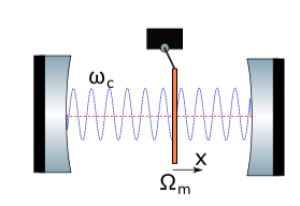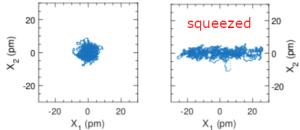Menu
Cavity opto mechanics
Why do we still not have observed quantum effects for macroscopic bodies? Is this connected to the quantum measurement problem, and should quantum mechanics be extended for such systems? Optomechanics is one of the research fields where these key fundamental questions in physics are investigated.

When light is reflected from a mechanical object such as a nanometer thick membrane or mirror, it exerts a radiation pressure force on it. Vice versa, the motion of this mechanical object will modulate the phase of the light in the cavity (reviews e.g., Cavity Optomechanics: Back-Action at the Mesoscale and Cavity optomechanics). This mutual interaction leads to intriguing effects such as optomechanical back-action, side-band cooling of the resonator or photon-phonon entanglement. Using this interactions, the mechanical resonator can be put into a spatial quantum superposition (a very small Schrödinger's cat), which is a big experimental challenge. We focus on relatively large (50 µm diameter, 25 nm thickness) and low-frequency (around 1 MHz) mechanical resonators.
This research has a long history in the group of Dirk Bouwmeester (see Towards Quantum Superpositions of a Mirror), and I joined the research efforts more recently. The team currently consists of Vitaly Fedoseev (Leiden), Fernando Luna and David Newsom (UCSB), and Dirk Bouwmeester (Leiden/UCSB).
Strong mechanical squeezing

Methods to prepare a mechanical oscillator in a squeezed state are important to enhance the read-out sensitivity and to reduce the measurement backaction in the quadrature of interest. Squeezing can happen on the few-quanta level but also of thermally excited states, where squeezing basically means that two quadratures (sin and cos) of the motion of a mechanical oscillator have a different temperature. Here we demonstrate thermal squeezing in the resolved-sideband regime, where the linewidth of the optical cavity is much smaller than the mechanical frequency. Normal squeezing is limited to the so-called 3 dB limit because instabilities occur, we circumvent this by direct feedback control of the mechanical oscillator using the electric force by a small needle.
Strong Thermo-mechanical Squeezing in a far detuned Membrane-in-the-middle System, Sameer Sonar, Vitaly Fedoseev, Matthew Weaver, Fernando Luna, Elger Vlieg, Harmen van der Meer, Dirk Bouwmeester, Wolfgang Löffler, Phys. Rev. A 98, 013804 (2018), Arxiv:1805.09897
Phonon interferometry

To study quantum decoherence, the evolution of the (quantum) mechanical system has to be observed possibly over long (seconds) time scales. This is very difficult in quantum optomechanics with a single mechanical mode because the photon has to be stored for a long time coherently. Here we investigate another method that exploits entanglement between different mechanical oscillators (or modes), which is possibly a much more easy approach.
Phonon Interferometry for Measuring Quantum Decoherence, Matthew J. Weaver, David Newsom, Fernando Luna, Wolfgang Löffler, Dirk Bouwmeester, Phys. Rev. A 97, 063832 (2018), Arxiv:1802.08399
